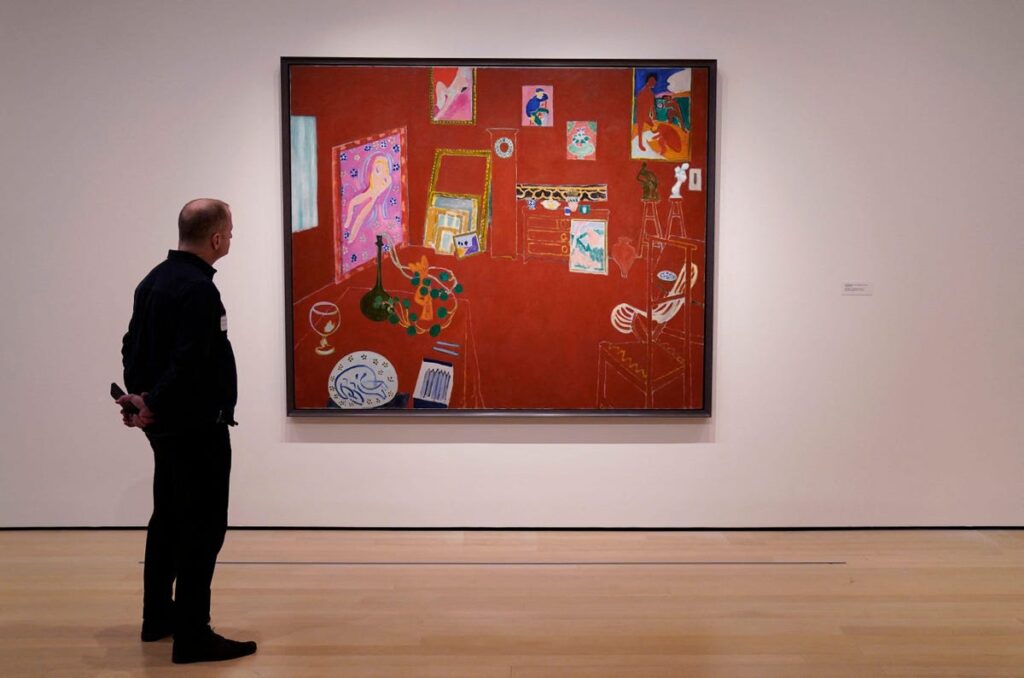On a recent trip to New York and its summer environs, I was struck by what was in some ways a small exhibition centered on just one painting, quite well known, that is more than 110 years old and that has been part of a museum collection for more than 75 years: Matisse, The Red Studio which is on view through September 10, 2022.
The Red Studio is an iconic Matisse work: The large (6’ X 7’) painting is suffused with a warm clay-like red that I associate with Mediterranean climes and that speaks to the Fauvist use of color. However, The Red Studio leaves Fauvism behind for a distorted and flattened perspective that includes the furniture in the studio as well as several works, sculptures, and a ceramic, rendered with the simplified line that would be Matisse’s late career signature. In this way, The Red Studio is a hinge work in the Artist’s career, as well as in Art History itself, as it represents a departure and a new direction.
What MoMa has cleverly done is to double down on an iconic painting in their own collection and built an exhibition around it. So, for example, there are artifacts surrounding the construction of the studio, with correspondence between Matisse and the architects and engineers concerning the dimensions – and photos of it from various perspectives. The exhibition also brings together the surviving six paintings, three sculptures and one ceramic that appear in the large painting.
What’s fun about this exhibition is that it is like a detective story or an archaeological excavation – we are digging for the story, and the works that belong to that story.
Looking at the painting today one is drawn in by its seductive beauty as the painting itself feels emblematic of Matisse’s work. However, when the painting was first shown, it attracted no attention. Here’s what MoMa says about this work: “For many years after its creation, Henri Matisse’s The Red Studio (1911)—which depicts the artist’s work space in the Parisian suburb of Issy-les-Moulineaux—was met with bafflement or indifference. Today it is known as a foundational work of modern art and a landmark in the centuries-long tradition of studio painting.”
The Red Studio was originally commissioned by Sergei Shchukin, a Russian textile tycoon who was one of Matisse’s patrons, for his Moscow home. However, after Shchukin received the painting in 1911, he rejected it. It was eventually purchased in 1927 by David Tennant and hung in The Gargoyle Club, a London literary club before being purchased by the Museum of Modern Art in 1949.
The idea of a painting that features other paintings was not novel. We see examples of these from the Renaissance on, of paintings of the Academy, or of galleries, or even of other artists’ studios. However, what Matisse did was to impose his own signature – key among them the radical flatness for which his work would later be known as well as a distorted perspective of the room. Notably, the left corner of the room disappears while the table in the foreground juts forward at an impossible angle; while the chairs on the right are rendered to give depth in a painting that is overwhelmingly flat.
Like the Cubism of Picasso and Braque there is an analytical breakdown of depth and perception but here it is not intellectual and cold; like the Fauvists and Expressionists, the Red of the Studio conveys feeling. Like Surrealists such as Dali, Matisse is trying to convey the subjective and psychological feeling of an environment. Finally, like abstract artists such as Kandinsky, we see a push towards decorative abstraction – which Matisse would never fully embrace or entirely reject.
 Forbes Lifestyle 01:12
Forbes Lifestyle 01:12



 Caribbean Getaway: There Are NewReasons To Go To Turks & Caicos
Caribbean Getaway: There Are NewReasons To Go To Turks & Caicos
Instead, The Red Studio is a manifesto making the case that what matters most to Matisse is what occurs in his studio. It is a landscape of his own invention, of creativity, of emotion expressed in decorative motifs and colors where the studio is a vessel for the artworks he is working on. Like a prima ballerina, Matisse makes the case for working very hard to make what we see look easy. Matisse invites us to make the leap into this world – if one looks closely, he’s left two colored pencils on a table as an invitation to creativity.
The artworks that figure in The Red Studio will, over time, have their own lives. Even the Venetian red that Matisse uses will appear in another major painting, “Large Red Interior” (1948). which is on display at MoMa; and the red itself will go on to influence painters such as Rothko and Barnett Newman.
Too often one races through MoMa in a hurry to see Art’s greatest hits and absorb whatever new exhibit is on showcase. The Red Studio reminds us of all that we can see in just one painting.

